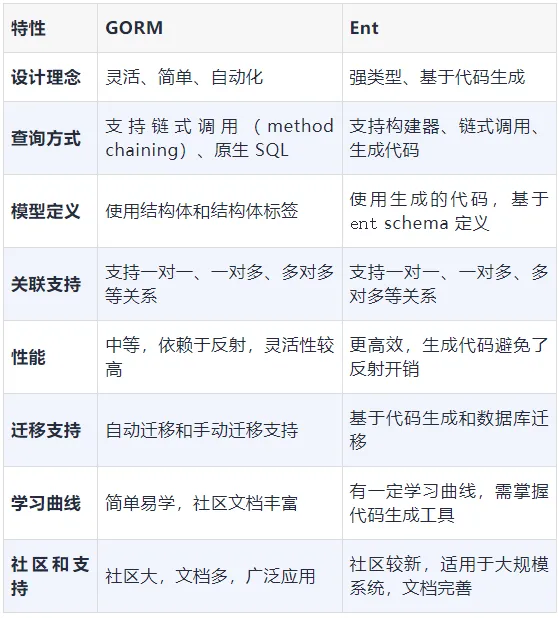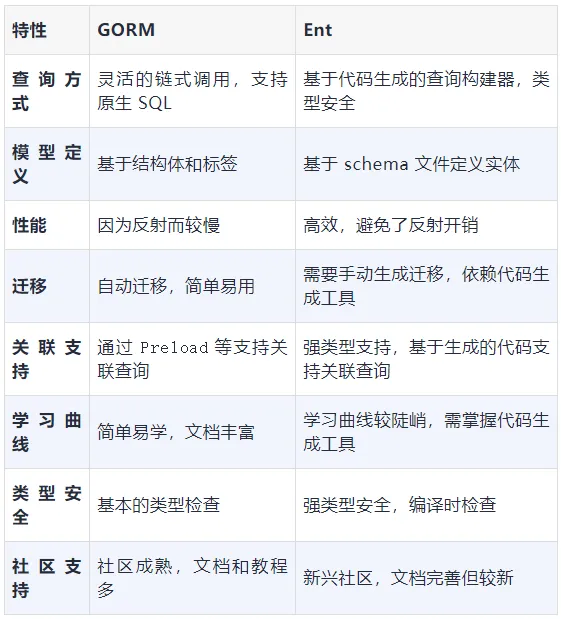在 Go 语言的 ORM(Object-Relational Mapping)库中,GORM 和 Ent 是两个非常流行的选择。它们都为 Go 提供了高效的数据库操作和对象映射功能,但在设计理念、功能特点、使用方式以及性能方面有所不同。下面我们将通过对比两者的特性,帮助你了解哪个框架更适合你的项目需求。
1. 概述
- GORM:
a.GORM 是一个流行的 Go ORM 库,广泛应用于 Go 项目中。它的特点是易于使用和灵活,支持常见的数据库操作,如创建、读取、更新和删除(CRUD),并且提供了丰富的功能,诸如关联查询、事务、自动迁移等。
b.GORM 采用基于结构体的方式进行模型定义,并通过标签(tags)定义表结构和字段。
- Ent:
- Ent 是由 Facebook 开发的一个 Go ORM 库,旨在提供强类型的、基于代码生成的数据库访问。Ent 侧重于代码生成,借助代码生成工具生成实体、查询构建器和数据库迁移代码,避免了手写 SQL 或构建复杂的查询。
- Ent 更加注重类型安全和高效的查询构建,适合大型项目和复杂数据库架构。
2. 主要差异

3. 代码示例对比
3.1 GORM 示例
假设我们有一个简单的 User 和 Profile 之间的一对一关系:
package main
import (
"gorm.io/driver/sqlite"
"gorm.io/gorm"
"fmt"
)
type User struct {
ID uint
Name string
Profile Profile
}
type Profile struct {
ID uint
UserID uint
Age int
}
func main() {
// 初始化数据库连接
db, err := gorm.Open(sqlite.Open("gorm.db"), &gorm.Config{})
if err != nil {
fmt.Println("Error:", err)
return
}
// 自动迁移
db.AutoMigrate(&User{}, &Profile{})
// 创建数据
user := User{Name: "John", Profile: Profile{Age: 30}}
db.Create(&user)
// 查询并关联
var result User
db.Preload("Profile").First(&result, "name = ?", "John")
fmt.Println(result)
}特点:
- 使用
gorm标签自动映射数据库表。 - 使用
Preload来加载关联的Profile数据。 - 自动迁移功能,快速构建数据库。
3.2 Ent 示例
假设我们有一个类似的 User 和 Profile 模型:
首先,定义 schema 文件(user.go 和 profile.go)。
ent/schema/user.go:
package schema
import (
"entgo.io/ent"
"entgo.io/ent/schema/edge"
)
// User holds the schema definition for the User entity.
type User struct {
ent.Schema
}
// Fields of the User.
func (User) Fields() []ent.Field {
return []ent.Field{
field.String("name").
NotEmpty(),
}
}
// Edges of the User.
func (User) Edges() []ent.Edge {
return []ent.Edge{
edge.To("profile", Profile.Type).
Unique(),
}
}ent/schema/profile.go:
package schema
import (
"entgo.io/ent"
"entgo.io/ent/schema/edge"
)
// Profile holds the schema definition for the Profile entity.
type Profile struct {
ent.Schema
}
// Fields of the Profile.
func (Profile) Fields() []ent.Field {
return []ent.Field{
field.Int("age").
Positive(),
}
}
// Edges of the Profile.
func (Profile) Edges() []ent.Edge {
return []ent.Edge{
edge.From("user", User.Type).
Ref("profile").
Unique(),
}
}接下来,通过 ent 工具生成代码:
go run entgo.io/ent/cmd/ent generate ./ent/schema然后,你可以像下面这样使用生成的代码:
package main
import (
"context"
"fmt"
"log"
"entgo.io/ent/dialect/sql"
_ "github.com/mattn/go-sqlite3"
"myapp/ent"
)
func main() {
client, err := ent.Open(sqlite.Open("ent.db"), &ent.Config{})
if err != nil {
log.Fatal("Failed to connect to database:", err)
}
defer client.Close()
// 执行迁移
if err := client.Schema.Create(context.Background()); err != nil {
log.Fatal("Failed to create schema:", err)
}
// 创建 User 和 Profile
user, err := client.User.
Create().
SetName("John").
SetProfileAge(30).
Save(context.Background())
if err != nil {
log.Fatal("Failed to create user:", err)
}
// 查询 User 并预加载 Profile
result, err := client.User.Query().
Where(user.Name("John")).
WithProfile().
Only(context.Background())
if err != nil {
log.Fatal("Failed to query user:", err)
}
// 输出结果
fmt.Println("User:", result)
}特点:
- 使用 Ent schema 来定义数据模型和关联关系。
- 使用 生成的代码 来进行查询和数据操作(通过构建器模式)。
- 需要生成代码,且对数据库操作有强类型的保障。
4. 对比总结

5. 选择建议
- 选择 GORM:如果你需要一个快速、灵活的 ORM,支持丰富的功能,并且在项目中不需要特别复杂的类型安全或生成代码的机制,GORM 是一个很好的选择。它有着非常活跃的社区和大量的文档资源,适合小到中型项目。
- 选择 Ent:如果你对类型安全和性能有更高的要求,或者项目比较大,需要一个强类型的查询构建器,Ent 是一个更适合的选择。Ent 可以帮助你更好地组织代码,尤其是在复杂数据库和多表关联的场景下。它适合大型、复杂的项目,尤其是当你的团队更注重代码生成和类型安全时。
6. 总结
- GORM 更适合需要快速开发和灵活操作的项目,尤其是中小型项目。
- Ent 更适合对类型安全、性能和可维护性要求较高的项目,尤其是大型系统。



































